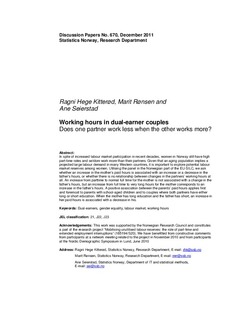| dc.description.abstract | Abstract:
In spite of increased labour market participation in recent decades, women in Norway still have high part-time rates and seldom work more than their partners. Given that an aging population implies a projected large labour demand in many Western countries, it is important to explore potential labour market reserves among women. Utilising the panel in the Norwegian part of the EU-SILC, we ask whether an increase in the mother’s paid hours is associated with an increase or a decrease in the father’s hours, or whether there is no relationship between changes in the partners’ working hours at all. An increase from parttime to normal full time for the mother is not associated with a change in the father’s hours, but an increase from full time to very long hours for the mother corresponds to an increase in the father’s hours. A positive association between the parents’ paid hours applies first and foremost to parents with school-aged children and to couples where both partners have either long or short education. When the mother has long education and the father has short, an increase in her paid hours is associated with a decrease in his.
Keywords: Dual-earners, gender equality, labour market, working hours
_____________ Sammendrag: Til tross for økt yrkesdeltakelse de siste åra, jobber kvinner i Norge ofte deltid, og få jobber mer enn
vanlig fulltid. De få som har lang arbeidstid, har oftest en partner som jobber minst like mye som dem
selv, eller mer. Kvinner jobber dermed ofte mindre enn sin partner, og dette gjelder særlig blant par
med barn i husholdningen. Gitt den sterke etterspørselen etter arbeidskraft i mange kvinnedominerte
yrker, er det viktig å diskutere mulige kilder til arbeidskraftreserver blant kvinner. I dette paperet
undersøker vi sammenhengen mellom endringer i partenes arbeidstid i to-inntektspar med barn i
husholdningen. Vi spør om en økning i mors arbeidstid går sammen med en økning eller nedgang i
fars arbeidstid, eller om det ikke er noen sammenheng mellom endringer i partenes arbeidstid i det
hele tatt. Analysene er basert på paneldelen i den norske delen av EU-SILC (European Union Statistics
on Income and Living Conditions). Hver person deltar i undersøkelsen åtte år på rad. Undersøkelsen
gir informasjon om både respondentens og partners vanlige ukentlige arbeidstid.
Det er ingen sammenheng mellom en økning fra deltidsarbeid og til vanlig heltid for mor på den ene
side og endringer i fars arbeidstid på den annen. Når mor øker fra vanlig fulltid og til lang ukentlig
arbeidstid, er det imidlertid også en økning i fars arbeidstid. Dette gjelder også når far i utgangspunktet
jobber minst 38 timer per uke. Slike par får da samlet sett veldig lang ukentlig arbeidstid. | no_NO |
